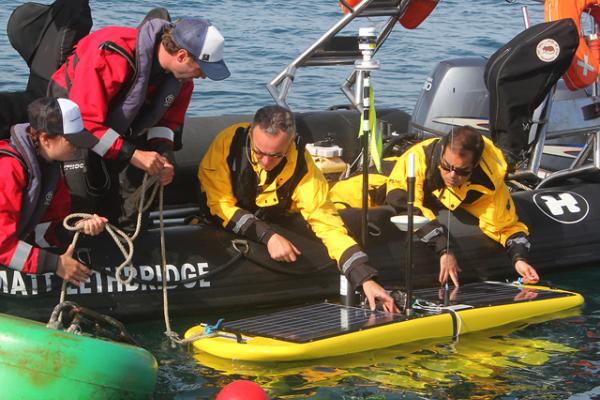
Robohub.org
British National Oceanographic Centre launches major unmanned exploration mission

The Waveglider receives last minute checks before being deployed. Source: British National Oceanography Centre.
Collecting oceanographic data is usually accomplished by a combination of satellites, buoys and research ships. All those methods have their limitations (e.g. buoys are only gathering info from a fixed location) and can be expensive. That is especially the case with large, crewed research vessels. One solution to overcome these constraints is the use of marine drones, autonomous surface or underwater vehicles capable of traversing great distances and operating independently for prolonged periods of time. The latest project to take advantage of the benefits of marine drones – the Robotic Exploration of Ocean Fronts by the British National Oceanographic Centre (NOC) – is one of largest and most ambitious unmanned ocean exploration missions to date.
At the beginning of October, a fleet of seven marine drones were launched from the Isles of Scilly for a three-week journey across the ocean. The target area for exploration is an area of ocean marking the boundary between Atlantic waters and English Channel. These boundaries are called fronts, and they separate water masses of different properties. The targeted fronts off southwest UK provide ideal conditions for abundant plankton growth, which in turn can attract large numbers of fish, seabirds, dolphins and basking sharks.
The vehicles carry a range of instruments for observing these animals. As well as measuring the temperature of the water and the weather conditions at the ocean surface, they can detect the density of plankton in the water, listen for clicks and whistles of dolphins and porpoises, and image seabirds using surface cameras. This data will help scientists map the distribution of the fronts and their associated fauna.
There are four types of marine drones used in this research mission:
Autonaut
Autonaut is a solar- and methanol fuel cell-powered autonomous surface vessel. It was developed by MOST (Autonomous Vessels) Ltd, and is designed to gather oceanographic data over long periods of time.
C-Enduro
C-Enduro is an innovative long-endurance autonomous surface vehicle built by Autonomous Surface Vehicles (ASV). The vehicle was officially launched in March 2014. Built to operate in all marine environments, C-Enduro uses solar panels, a wind generator, a lightweight diesel generator and a self-righting hull to enable it to remain at sea for long periods.
Wave Glider
The Wave Glider is an autonomous, environmentally-friendly ocean-going vehicle, developed by Liquid Robotics. It is fitted with surface and sub-surface sensors to gather information such as water temperature and the atmospheric conditions above. It is roughly the size of a surf board and is equipped with computers for navigation and a satellite communication system. Three Wave Gliders have been deployed for this project.
Slocum Glider
The Slocum Glider, built by Teledyne Webb Research, is a high-endurance vehicle equipped with a variety of sensors. It can operate at depths of 1000 metres and can remain at sea for months at a time while transmitting data back to shore. Two gliders are used in the NOC project, and have been customized in order to cope with the demanding marine environment and to record different type of data.
The Robotic Exploration of Ocean Fronts project is divided into two phases. Phase one sees a fleet of seven marine drones being launched from a beach on the Isles of Scilly to travel up to 300 miles to the shelf edge and back. During this time, they will be taking measurements including chlorophyll, temperature and salinity, and also monitoring wildlife activity at the front. Phase two of the project sees further monitoring plus the tagging and release of 100 fish, which will be tracked using a new seabed and USV receiver.
Further information about the project available at the project’s official page.
Images and video courtesy of MOST Autonomous Vessels Ltd, Autonomous Surface Vehicles (ASV) and National Oceanographic Centre.
tags: EU, Mapping-Surveillance







